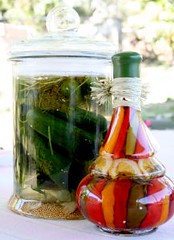 The Basics of Pickling
The Basics of Pickling
Written by Thea Mann
Pickling is a great way to preserve the bounty of summer, whether from your own garden or the local farmer’s market. This is a great way to take advantage of low summer produce prices and still have high-quality fruits and vegetables for yourself and your family all year long.
To start, you will need to use non-reactive utensils such as stainless steel pans, bowls and spoons. Glass bowls, chip-free enamel and food-grade plastic are also an acceptable choice. Wood will absorb the flavors and other kinds of metals will react with the high acid present in the pickled foods which will produce a poor taste or other undesirable results.
When pickling, always use the highest quality ingredients available. You will use vinegar, salt, a variety of spices and herbs, crisping and firming agents and water. You will also need the usual tools for canning: a pressure canner, bottle tongs, glass jars, lids and rings. If you will be making refrigerator pickles you will obviously not heat process, but it also means your pickles will not keep for a long period of time.
Commercial white vinegar or cider vinegar with 5% acidity are recommended. Some recipes may call of other kinds of vinegar and in these cases that is acceptable. However, it is important to keep the quantity of vinegar as the recipe requires. Vinegar is acting as a preservative and altering the recipe in this way may seriously reduce the preservative effect and spoil your final results.
For more natural colors, white vinegar is recommended. Cider vinegar is more mellow in flavor than white vinegar, but it may darken your fruits and vegetables. This is especially true for those that are light in color. White vinegar will not overpower the flavor of your pickling spices. It is especially recommended when pickling items which are white in color, such as cauliflower.
Salt should be only the kind called for in your recipe. Regular table salt and iodized salt will result in cloudy or discolored brine and may impact the overall flavor of your product. Pure granulated salt is also called pickling or canning salt and is available in the same location you would find other canning supplies. As with vinegar, salt is required in ensuring proper fermentation. Do not change the quantity of salt and maintain correct proportions of salt and water. Improper fermentation can result in spoiled food which can make those who eat it sick.
When planning your pickling, be sure to add only the freshest dried herbs and spices available. Those that have lingered in your pantry for months on end may you’re your foods an off taste or even create a cloudy and unappealing brine. Using powdered seasonings can also negatively impact your end product, so stick to whole spices and herbs. Some people prefer to add whole herbs and spices in a small cheesecloth bag rather than deposit them directly into the brine. Either method is acceptable.
Soft water is recommended as hard water can have minerals that will damage the taste and texture of your pickled foods. If you like, it is possible to soften your water through 15-minutes of boiling. Use a large stainless steel sauce pan for this. Once you have boiled your water, let it stand for 24 hours, then skim off any surface scum. As sediment will have formed on the bottom, carefully ladle your now-softened water into another container and discard the remainder.
You can add pickling lime, alum or even grape leaves to make your pickles more crisp, however, they can add flavors to your recipes. Firming and crisping agents aren’t required if you are using fresh produce. However, if you are so inclined, calcium chloride (found in the canning section) can be added to enhance the texture of your recipes.
When choosing the produce you will use, choose the freshest and the firmest. There should be no signs of discoloration or deterioration. It is best to pickle within 24 hours of picking to ensure the best quality product. When using cucumbers, do not use waxed cucumbers; the coating will prevent the brine from doing its job. Be sure to scrub your unpeeled fruits and vegetables with a soft brush to remove any dirt or bacteria.
Although pickled foods are highly acidic (usually through the addition of vinegar or through fermentation) you will need to boiling-water process your filled jars. This goes against a lot of folk-wisdom about hot-processed pickles, but as this final step kills bad bacteria that can make you sick and also halts the activity of the enzymes which influence the color and taste of your end product, this is a step you do not want to skip. Again, the exception to this is refrigerator pickles, but do not expect that they will keep for more than a few months.
Be sure to follow your recipes closely as you begin canning and pickling. As you become more experienced and understand the processes involved you may find yourself creating your own recipes.










Speak Your Mind